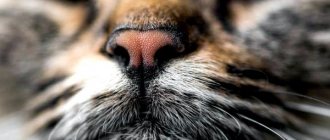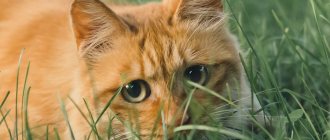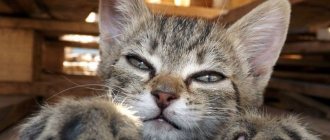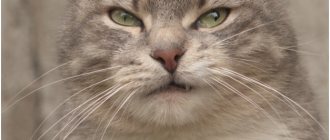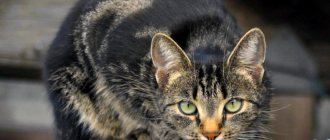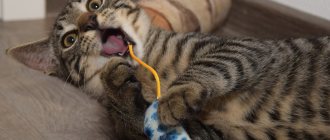If you are an avid gardener and pet owner at the same time, you should know that there are houseplants that are poisonous to dogs and cats. Oleanders, epipremnums, azaleas, crotons, caladiums, monsteras, dieffenbachias, poinsettias, philodendrons, many ficuses and lilies are toxic...
But what to do if you want beauty in your apartment, but you are under no circumstances ready to get rid of your four-legged family pet? Don't panic - there are many types of ornamental flowering and ornamental foliage plants that are safe for animals.
Today we have prepared for you a small selection of such flowers, which if you start them at home, you won’t have to worry about the health of dogs and cats at all, even if they try the plants or taste the water from the trays.
Pilea
Various ornamental pileas belong to the Nettle family. Unlike their wild relatives, indoor Pileas have a wide variety of sizes, textures, colors and shapes of leaves - sometimes it’s even hard to believe that they all belong to the same genus.
The leaves of different saws can be glossy or pubescent, flat or curved, tiny or large, smooth or with bubbly protrusions of various shapes, sharp-toothed or perfectly round, plain (green, brown, red-brown) or covered with contrasting spots and stripes... But they bloom these beauties are very inconspicuous and almost invisible.
Various types of pili may be sold under "folk" names such as "Chinese money tree", "mission plant", "aluminum plant", "Japanese dollar", "Creeping Charlie", etc.
An abundance of bright direct light is contraindicated for Pileas - they are adherents of partial shade and diffused lighting. It will tolerate short-term drought well, but ideally the plant likes frequent but light watering with mandatory drying of the surface layer of soil between procedures and summer spraying (excess moisture from the trays must be drained, especially in the cold season). She also doesn’t need heat, the optimal growing temperature is 15-18°C in winter and not higher than 20-25°C in summer. The plant needs year-round universal fertilizing - once a month in winter, 2 times a month the rest of the time.
The beneficial effect of pili on the composition of the air in the house is also known.
- Indoor flowers for your kitchen: 20 ideal options
Indoor flowers suitable for growing in the kitchen.
"Love does not love"
“Favorite” smells for cats are those that tell them about the presence of food (the aroma of raw beef, chicken entrails, fish remains) or the presence of a sexual partner. Most cat scents that are attractive to humans are frightening or repulsive. Knowing the characteristics of a cat’s perception of odors, you can protect furniture, textiles, and carpets from the encroachments of a furry pet.
Least favorite smells. Cats don't like the smell:
- citrus fruits;
- fragrant rue;
- eucalyptus;
- myrtle tree;
- Schisandra chinensis;
- tobacco and shag;
- Coleus dog;
- mustard;
- cayenne pepper;
- ground coffee and pepper;
- vinegar;
- perfume and cologne;
- laundry and tar soap.
Phalaenopsis
Phalaenopsis is perhaps the most common orchid in our apartments, a kind of “exotic for beginners.” And all because of her unpretentiousness.
This plant is epiphytic, it does not need soil, the orchid lives in a container with a special substrate based on the bark of coniferous trees. Direct sunlight can cause leaf burns, so place the phalaenopsis pot in an area with indirect light. Watering is required abundantly as the substrate dries. The optimal growing temperature is not lower than 22°C in summer and not lower than 18°C in winter.
Phalaenopsis has many decorative varieties and varieties, differing in the size of the plant, the number of peduncles, the size and color of flowers, the shape of buds, the duration of flowering, and so on.
- Mini, midi, standard and other varieties of phalaenopsis (+ the best varieties and hybrids)
Did you know that phalaenopsis plants can differ not only in the color of their buds?
Should you plant a poisonous plant?
Although cats are generally recognized as witches’ helpers, observation has shown that they have absolutely no understanding of plants. Therefore, the belief that you can plant a flower with poisonous juice, and it will survive the next attack of herbivory by the shaggy prankster, is incorrect and very dangerous.
The cat will definitely test its body's strength by feasting on the plant, and then you will spend a long time and persistently treating its diarrhea, vomiting or more serious poisoning. Moreover, after healing a little, he will remember that he has not yet managed to gnaw everything and stomps towards the insidious plant. No one has yet determined exactly which flowers cats do not eat, so there is no point in experimenting with such drastic methods.
Maranta
A beautiful arrowroot of American origin. Several species of this perennial herbaceous plant are popular in indoor floriculture. They differ mainly in the color of the wide, large leaves, which may have red or silver veins, as well as different-sized, multi-colored and variegated spots.
This plant is often called the “prayer flower” for its unusual ability to lift its foliage upward, for example, in the evening or under unfavorable growing conditions. It is also considered a flower that brings positive energy to the home.
Maranta is generally unpretentious. She prefers slightly acidic, fertile, well-drained soil, high air humidity, and bright but diffuse lighting. The optimal growing temperature is 21-27°C during the day and not lower than 15°C at night. Fertilizing (alternately organic and mineral) is carried out throughout the year at intervals of two weeks.
- Indoor plants that attract luck, money and bring happiness to the home
The magical properties of these plants can completely change your life! They are also suitable as a useful gift.
Plants that are good for cats
Decorative plants in the interior can be not only safe, but even beneficial for domestic cats. If you place attractive and useful vegetation within your cat’s reach, it is likely that he will not pay attention to other flowers.
Useful indoor plants for cats include those that:
- pleasant to the taste;
- rich in vitamins;
- have medicinal properties;
- promote regurgitation of hairballs.
For example, calendula is an edible plant for cats that does not pose a threat to life if any part of it is eaten. Flowers, leaves and stems contain vitamins, essential oils, have anti-inflammatory, healing properties, and to some extent protect the liver. Calendula is even often included in medicinal feeds.
Oats - sprouted oat grains can often be found for sale on the shelves of pet stores. It’s also not difficult to germinate oats yourself, and your domestic cat will benefit a lot. Especially if the animal never goes outside at all. The rough texture of the leaves, which your cat enjoys eating, can help cleanse the stomach of ingested fur. If your pet vomits hairballs after eating oats, this is a normal result.
Catnip (catnip) is a neutral herb for cats. To a greater extent, the eaten leaves and stems affect the psycho-emotional state of the animal, making it excited or, on the contrary, peaceful, depending on its temperament. And a third of cats do not react to this plant at all.
Any useful flowers for cats should be within easy reach. All edible vegetation should serve as an attractant (attract the attention) of cats, distracting them from decorative flowers. Chewing and eating such greens is harmless to your pet, but excessive consumption of even healthy herbs can lead to a transient effect (dyspepsia) and other undesirable consequences. Although there is nothing fatal in this, the owner must be careful and take the plant away in time if the cat gets carried away.
Maidenhair
Small, fast-growing maidenhair ferns with creeping rhizomes and a “mane” of delicate feathery leaves can become a real decoration for your indoor flower garden.
Adinatums love humidity and warmth, but they cannot tolerate bright light - place them in partial shade. In addition to regular watering (preferably in a tray), they definitely require spraying (daily in the warm season). The growing temperature, even in winter and at night, should not fall below 15°C. Adianthuses are replanted once every two years, and in spring and autumn they are fed with complex fertilizer for ornamental foliage plants. In the spring, sanitary pruning of the plant is carried out to maintain its decorative appearance.
Many adianthuses do not tolerate air pollution very well, including cigarette smoke.
The easiest to grow are Ruddy's adiantum, "Venus hair", delicate and finely pubescent.
- Plants for the winter garden - which ones are right for you
Proven plants for the winter garden in the greenhouse, insulated veranda and indoors.
Chlorophytum
Let's start with the foliage, which is sure to get noticed. Chlorophytum has long, pointed leaves that create a dramatic effect without overwhelming the room.
This plant can be placed on the mantelpiece. In fact, the properties of chlorophytum are that it is capable of producing hanging “shoots”. This cascading nature makes it ideal for hanging baskets. Chlorophytum thrives when placed near a window. This plant needs to dry out between waterings, giving you plenty of time to remember to water it!
Hibiscus
Beautifully flowering hibiscus can not only be a magnificent garden decoration, but also a compact indoor plant - most often in indoor floriculture, the species called the “Chinese rose” is used. Over the past few decades, many colorful varieties have been developed. Scarlet, white, pink, yellow, orange, as well as two-color huge hibiscus flowers with delicate thin petals will not leave any gardener indifferent.
This plant is fast growing, loves a lot of diffused light, frequent spraying (water should not get on the flowers!) and abundant watering. The optimal growing temperature is 20-23°C in summer and 14-17°C in winter. Hibiscus easily forgives small errors in care for beginning flower growers.
In the East, this plant is considered a guardian of the home, and hibiscus flowers can also be eaten - they can be fried in batter with cheese and breadcrumbs, added fresh to salads, or decorated with desserts and drinks.
- Flowers you can eat
9 plants from the flowerbed that can be added to a salad, pickled, stewed or placed on a cake as a decoration.
What plants can cats eat?
It’s not that all cats, without exception, eat any plants. But for a number of reasons this happens quite often. Some nibble leaves and stems out of curiosity, because of the attractive taste or smell. Or even because the hunting instinct awakens when the leaves sway in a draft. And especially cunning individuals like to attract the owner’s attention in this way. There is nothing wrong with this if a competent owner has furnished the room with indoor flowers that are safe for cats.
Article continues after advertisement
When flowerpots are already in the house, the cat is actively interested in them, but their benefits have not been confirmed, then you should find out the names of the plants and check them with the list of poisonous ones. If it turns out that your flowers are harmless to cats, there is no need to worry. It is better to get rid of the rest of the flora or replace it with a more suitable one.
Indoor plants that are not fatal to cats, but can cause signs of poisoning, can be left in the apartment if the pet is not at all interested in them. But to be on the safe side, it is better to take measures to reduce the attractiveness of the above-ground part for the cat: mulch, spray with citrus essential oil, plant around the flower herbs that repel the smell or bitterness, for example, mint. But it is safest to place plants in your home that are known to be non-poisonous to cats.
When buying new flowers for the interior, it would be a good idea to ask the seller if he has treated them with pesticides against diseases or insects. Recently sprayed seedlings can cause cat poisoning, even if the plant itself is not dangerous. Colored fertilizers can be added to the soil in the form of balls, pebbles, sticks, which can also attract a curious pet and cause intoxication and even death. But most often the fertilizer or spray preparation is not visible to the human eye.
If the cat has already consumed the flower, if there is any suspicion of poisoning, you should immediately contact your veterinarian and tell him what plants or fertilizers the animal became ill after contact with. In some cases, an urgent visit to the veterinary clinic may be required.
It is easier to prevent any trouble by wisely selecting plants for a home with animals. First of all, you should pay attention to the list of plants that are safe for cats, and even better - useful and attractive to them. Use these colors to decorate your interior.
Indoor flowers safe for cats:
- asparagus;
- Boston fern;
- bromeliads;
- Venus flytrap;
- gloxinia;
- calathea;
- coleus;
- arrowroot (prayer book);
- Areca palm;
- Pilea Glauca;
- Pilea Cadieux;
- Pilea peperomyoid;
- Pilea Spruce;
- miniature roses;
- Saintpaulia;
- staghorn fern;
- phalaenopsis orchid;
- chamedorea gracilis;
- chlorophytum;
- hoya (wax ivy);
- Schlumbergera (Christmas).
Herbs safe for cats:
- basil;
- coriander;
- catnip (catnip);
- lavender;
- mint;
- parsley;
- rosemary;
- licorice;
- thyme (thyme);
- dill;
- sage.
There are a lot of pet-safe indoor plants. They vary in light requirements, shape and size, as well as in the degree of unpretentiousness. By limiting yourself only to varieties that are harmless to pets, you can create unique interior compositions, enliven and decorate the space in the house, without harming small members of the family.
Article continues after advertisement
Deterrent fume
- Do not forget that felines have a poor sense of smell, so they cannot tolerate strong odors. You can use the sim. It is enough to take alcohol, a table bite, that is (i.e.) the zest of any citrus fruit. As an alternative, it is recommended to use black, pink, allspice and red pepper.
- You can use essences and citrus esters. Alcohol tinctures and fresh citrus peels are suitable. It’s also easy to make your own natural repeller for furry pests.
- It is enough to soak a cotton pad with a bite or alcohol. Keep in mind that such a palliative is only temporary. After the smell evaporates, the four-legged confidant can again take up old business. Therefore, every time you have to prepare a new trap.
How to protect flowers from a cat: how to scare away the animal
A pet in an apartment requires the attention of its owners. Dogs and cats often cause a lot of trouble for their owners. For example, cats can damage indoor plants.
They rummage through pots, “confusing” them with the tray, and chew stems and leaves. During play or due to carelessness, an animal may even turn over a pot with an indoor flower onto the floor. All this can be avoided if you think in advance about how to protect flowers from increased attention from your pet.
The problem is solved in two directions. On the one hand, it is necessary to rid the cat of the bad habit of spoiling plants, on the other hand, it is necessary to make such contacts impossible.
To wean your pet from the habit of “flirting” with flowers, you need positive reinforcement for correct behavior and negative reinforcement for prohibited actions.
An important point: you can’t hit cats. These capricious animals rarely associate physical impact with their behavior, and may simply become offended by their owners.
As a negative reinforcement, the fluffy can be slightly frightened. As soon as the owner notices that the cat is showing the “wrong” interest in a house plant, you can make a sharp sound: a whistle, a knock, a bell.
For this method to bear fruit, you will have to spend time. It is necessary to monitor every approach of the cat to the windowsill, otherwise a new conditioned reflex may not form.
You can build an unstable pyramid of tin cans near the pots. It is likely that the cat will knock it over and next time will be afraid to approach the potty.
You can scare a cat away from indoor plants using scents. Cats really don't like citrus scents. You need to take fresh lemon or orange juice, moisten a few pieces of cotton wool with it and put them in the pot. Over time, the smell disappears, which means the cotton balls need to be periodically replaced with fresh ones.
Unusual entertainment
Like people, our pets can not only be sad and happy, but, for example, also be bored.
And boredom causes the most seemingly absurd situations to happen. A bored cat may become interested in a potted flower out of curiosity. He sniffs, touches with his paw, bites the moving leaves and flowers, if he really likes it, he can dig up the ground, and “accidentally” drop the pot on the floor - everything is more fun than just lying on the bed. You can also tease your owners out of boredom. Many cat owners know firsthand that their pets deliberately do what they are often scolded for: sharpening their claws on furniture, throwing objects off the table, picking at the soil in a flower pot. And how interesting it is for them to then run away from an angry owner and hide under the sofa or behind a closet. What don't you do when there is nothing else to do?
How to prevent problems
Even if you love your pet very much, do not indulge his gastronomic whims.
You cannot feed these little ones with anything other than the standard and familiar food for them. Be vigilant on holidays when guests come to the house. Our murkas and tobiks love to pretend to be poor and hungry in order to get from the hands of guests a tasty morsel that is harmful to their health, poisonous. It is necessary to keep household chemicals, pesticides, cleaning agents and detergents out of the reach of animals. Under no circumstances should you treat an apartment, house, cottage, or garden against harmful insects or rodents when our pets live there. After such treatment, you should thoroughly clean and ventilate the room before you bring your pets back into it.
Yes, more about house flowers. Those that turned out to be poisonous for the “children” must be removed from the house. It can be very sad to part with green pets. But we have to! For the health of others - eared and tailed. If it is not possible to relocate poisonous plants to places inaccessible to animals, then it is better to donate them to those houses where there are no animals. May our little brothers always be healthy, cheerful and cheerful. Just like you and me! Yeah?
Galina Golygina
Placiterium staghorn
If you have a cat at home, then try to choose suitable types of plants for landscaping. For cat owners, the staghorn fern is ideal. In nature, it grows on tree trunks and branches. At home, platicerium is grown on vertical blocks that can be mounted high on the wall.
What is worth seeing in Sao Paulo: the inimitable Ibirapuera Park
Traveling for your love: what type of vacation to choose to strengthen your relationship
The penalty for laziness: how to maintain high productivity with low motivation
Platycerium staghorn is an unpretentious plant. It requires watering only once a week. The leaves of this fern contain no toxins and are safe for cats.
Ficus
Look how well the ficus looks stylish in an indoor pot, with the surface of its leaves shining! It's beautiful and requires minimal care. The waxy round leaves give it a special shine and a shape that fits perfectly into any pot. And, what is very important, ficus is harmless to animals.
Ficus loves bright, diffused light. You can let the soil dry out almost completely between waterings, this makes caring for it quite easy.
Healthy greens for cats
How lucky are cats living in rural areas? In the warm season, the owner can let the cat out into the garden, and there it will be full of delicious herbs that will cleanse the body and cure ailments. City cats quietly mutter on the sidelines; they are deprived of such luxury.
But a loving owner can grow these green “dishes” on his windowsill and arrange a kind of green garden for his beloved cat. This home garden will contain only safe plants. Which?
- Melissa;
- wheat;
- oats;
- barley;
- mint (field and watermint);
- ivy-shaped budra.
The cat will thank you very much for these goodies.
areca palm
Tropical greenery adds an exotic touch to your home, but is it safe for cats and dogs? It turns out that Areca palms are an excellent option. Their choice is quite large, it’s not difficult to choose exactly the one that suits your home.
This plant can be proudly displayed in a large pot and will instantly become the focal point of the room! Known for its air-purifying properties, the areca palm is fairly easy to care for. It is important not to overwater the plant, but to provide sufficient moisture when the soil begins to become dry.
In terms of lighting, the palm tree should gradually acclimate to indoor lighting. To do this, it is better to place it on the balcony in an area of partial shade. After a few weeks, you can move the plant inside to a fairly bright place.
